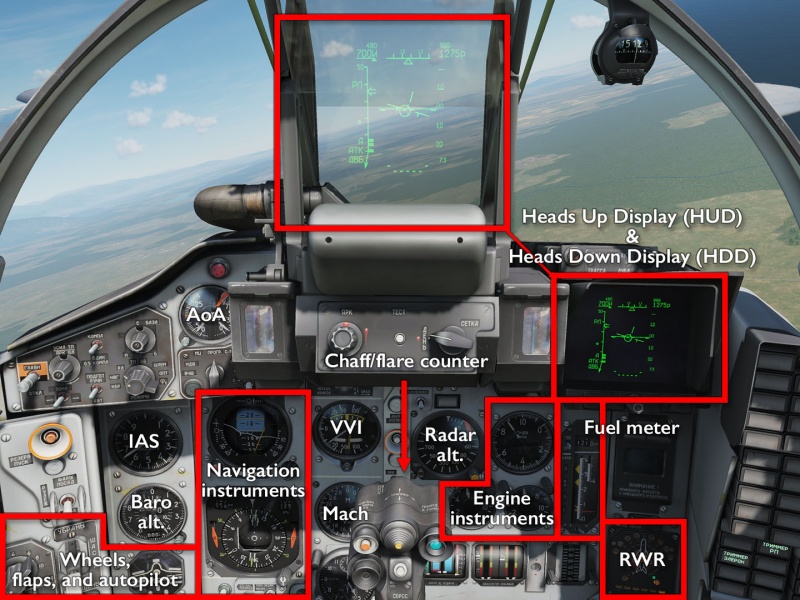MiG-29 Fulcrum: Difference between revisions
mNo edit summary |
m (→�) |
||
| Line 22: | Line 22: | ||
=== Cockpit overview === | === Cockpit overview === | ||
[[File:MiG-29 Dash.jpg|800px|frameless|MiG-29 Dashboard]] | [[File:MiG-29 Dash.jpg|800px|frameless|MiG-29 Dashboard]] | ||
The MiG-29 features classic shotgun-style cockpit design: no two related instruments may be next to each other or it is off to the Gulag for you. As a bonus point, the most important instrument (the fuel gauge) is not entire intuitive, and the next most important one (chaff/flare counter) is hidden behind the control stick. | The MiG-29 features classic shotgun-style cockpit design: no two related instruments may be next to each other or it is off to the Gulag for you. As a bonus point, the most important instrument (the fuel gauge) is not entire intuitive, and the next most important one (chaff/flare counter) is hidden behind the control stick. | ||
Revision as of 16:35, 15 June 2018
Originally a part of the aircraft selection in LOMAC, the MiG-29A, S and G (German variant) were ported over to DCS through the FC3 package.
Just like the other FC3 planes, the MiG-29 is more designed to be controlled through a standardised set of keyboard shortcuts than through any kind of advanced set of peripherals, nor does it feature an interactive “clicky” cockpit. Even among the FC3 planes, however, the MiG-29 sets itself apart by being the last aircraft in all of DCS to still use the scripting-driven Standard Flight Model (SFM).
Features
The MiG-29 is a curious mix of old and new. It is clear that it is still meant to rapidly take off and engage with enemies from bases close to the border, and to be guided by way of GCS. It has:
- A capable, if quirky, radar and R-77 active-homing medium-range missiles.
- IRST and R-27ET for emission-less terminal guidance and medium-range IR attacks.
- A drag chute for short landings.
- An 19th-century coal-burning steam engine, by the looks of the exhaust trail left behind.
- Some bombs and stuff that you will never use.
Comes with the built-in campaign MiG-29 - Over the Hump.
Flying the MiG-29
The MiG-29 is famous for being fast and nimble, and its DCS representation is all that… briefly. The most important instrument in the MiG-29 is the fuel indicator, because this is not a long-range interceptor — it's a tactical fighter (and optionally bomber) that flies to where it needs to be, does its thing, and immediately comes back.
The three variants are largely the same, except that the -S model carries more fuel, better radar and ECM, and can carry the R-77 active-homing missile. The export -G variant is much the same as the -A, except that it (for the most part) uses feet and kts rather than meters and km/h.
Cockpit overview
The MiG-29 features classic shotgun-style cockpit design: no two related instruments may be next to each other or it is off to the Gulag for you. As a bonus point, the most important instrument (the fuel gauge) is not entire intuitive, and the next most important one (chaff/flare counter) is hidden behind the control stick.
Getting into the air
The process of getting the MiG-29 into the air is the same as with all FC3 aircraft:
- Make sure you have loaded the correct weapons and filled up on chaff, flares, and fuel.
(This can only be done with the canopy open and engines off, press LAlt-' to open the outfitting menu.) - RShift-L to turn the power on.
- LCtrl-C to open or close the canopy, as needed.
- RShift-Home to start both engine at the same time.
(RShift-End stops both engines; RAlt/RCtrl-Home/End starts and stops the left and right engines individually.) - Wait for the engines to spool up and stabilise.
- Num+/- controls the throttle; increase it carefully to get going and do not go too fast.
(W controls wheel brakes; be particularly careful when turning since doing it at high speed will make you tip over, scrape your wings, catch fire, explode and — worst of all — become the subject of innumerable screen shots.) - Use Z and X to control nosewheel steering (and also rudder) to make your way to the runway and line up.
- LShift-F lowers the flaps — they should be in the middle position for takeoff.
- Throttle up to max and try to stay in a straight line as you barrel down the runway.
- Pull back gently to take off.
- Raise landing gears with LCtrl-G; raise flaps with LCtrl-F.
Shooting something
The fun part of flying the MiG-29, and the thing that made it feared and famous, is to sneak around without the radar on and use IRST to lob heat-seeking AA missiles at the enemy.
More information
- Mikoyan MiG-29 on wikpedia.
- MiG-29 FULCRUM on globalsecurity.org



